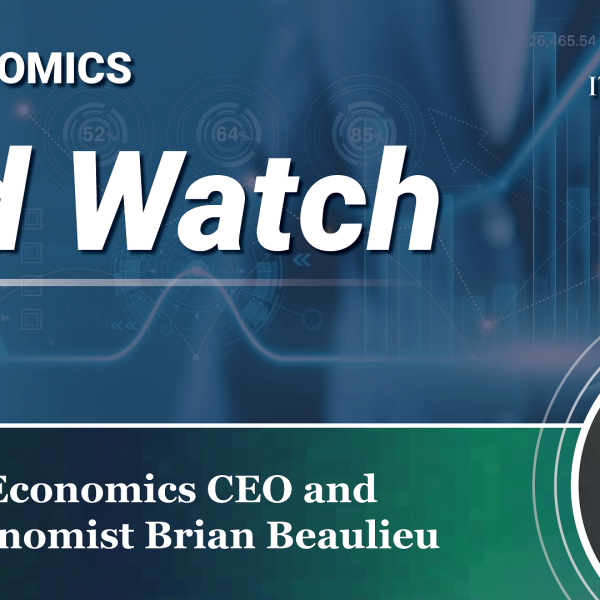- Mon - Fri: 8:30 - 5:00
- +1-603-796-2500
- ITR@itreconomics.com
with Brian Beaulieu
WEEKLY FED WATCH
Tune in to the latest episode of Fed Watch as ITR Economics Chief Economist Brian Beaulieu discusses the latest speech from US Chair of the Federal Reserve Jerome Powell, the impact of federal spending on the economy, and other key data trends.
Key Episode Takeaways
- 0:18 – US Chair of the Federal Reserve Jerome Powell’s latest speech
- 1:23 – Manufacturing wages are still elevated and wage concerns
- 2:03 – Housing permits and US Housing Starts data overview
- 4:31 – Data trends for retail sales
- 6:00 – Fed would have clearer path of lowering interest rates if not for federal spending
- 6:14 – Spending is having a greater impact on the economy than anticipated
- 6:38 – Key highlights from Alan Beaulieu’s blog on federal spending
- 6:55 – Summary and conclusion
The below transcript is a literal translation of the podcast audio that has been machine generated by Rev.
Hello, thank you for joining us for this edition of Fed Watch. Today is April 19th, 2024. Jerome Powell gave a speech earlier this week and he pretty clearly hinted, if you can clearly hint anything, that there could be a delay in the interest rate decline, and that obviously wasn’t good news, but not unexpected given everything going on with the March release of the PPI and the CPI. Both of those showed a little bit more stubborn inflation than the Fed was looking for. In fact, it was the Chicago Fed that was saying that really from their perspective, the problem is rents. From ours, we’ve cited rents in the past when that data came out, but it’s also a function of labor. Labor rates are still staying high, but rents for primary residents and rental equivalencies is definitely high. And according to the Chicago Fed, it’s not behaving as they anticipated their models would, particularly it seems in the Northeast and in the Midwest. Everything did a talk that was just yesterday.
I was noticing manufacturing wages are still running at very high levels. We really haven’t seen disinflation there either. And a lot of that could be tied into not the normal every day manufacturing that has defined our economy in the past, but ramping up manufacturing related to high-tech activity is likely going to keep wages elevated, and that’s a trend that’s already in place and not likely going to be dissuaded. So we have the concerns over the ongoing wage trend, not moderating and rental trends apparently not moderating the way they were supposed to. So that’s what’s going on on the one hand. On the other hand, there’s something interesting that occurred with the March data and across several different boundaries. For instance, housing. We’ve been talking about how housing has some nice green shoots, and in fact the first quarter numbers compared to the first quarter 2023 really looked good, but when we broke it down and looked at the month to month to month change for housing permits and housing starts, and let’s stick with permits, the drop with a lack of rise really from February to March was very significant.
It was recession like week, so we don’t know if that was just pulled into January end or February and that left a natural gap in March, or whether that’s the beginning of a shift in momentum. So we’ll watch that trend very carefully and report back to you as we get additional data in. When it came to retail sales, the month-to-month change in retail sales was the worst in 32 years, with the sole exception of during COVID. We use not seasonally-ingested data. The Fed, a lot of media sources report out on seasonally-ingested data. Normally they’re in pretty close alignment, but when others are saying retail sales look strong, but the unadjusted data says it looked anything but strong to us in March, that’s noteworthy. Our 112 rate changed for overall retail sales moderated down to 2.4%, so it’s coming back down to Earth quickly. The 312 weakened to 3.3%, so there’s considerable moderation in what has started out this year is very strong retail sales activity.
It seems to be peeling back, and not across the board either, and that was interesting. Big ticket items like automotive, the 112 dropped to minus 1.5, and that overall activity, it was the weakest February to March change in automotive sales over 32 years, except for COVID. It was worse than even during the great recession in 2008, so it really raised our eyebrows. Home-building supply stores continued to look very weak, the 312 dropped a little bit lower into -7.1%. It’s in Phase D, the 112 is in phase D as well, and it was the second-worst February to March in 32 years. Again, that trend is seemingly continuing. Where it wasn’t weak for retail sales was in general merchandise stores. They came in quite strong. I’m wondering if that isn’t reflecting a pinch in affordability of high-ticket items or major projects, and instead they can buy the day-to-day living type stuff, or normal birthday type stuff at these general merchandise stores.
If so, it could indicate that there will be ongoing slowing in the rate of rise in retail sales. We’re not thinking that overall retail sales is going to turn recessionary, but it seems likely to be slowing down further as we go deeper into 2034. And that same phenomena happened in existing home sales, started the year like a lion, and in March it turned into a lamb. We saw all rates of change weaken going down in already negative territory. They’re already below zero on the rate of change basis. March, as I said, came in week and the 12-month moving total dropped to its lowest level in about 12-and-a-half years. So it was some burgeoning good signs going on there. Now there’s a shadow of doubt cast upon those numbers for as of March anyways. The first quarter GDP numbers come out next week, so I’m hoping that it’ll shed some light on things, but that’s quarterly data at an annualized rate.
It doesn’t get into the of the month to month change. We’ll find out. I think the Fed would have a much clearer path to lowering interest rates if it wasn’t for all this deficit spending government financing of all these major projects laid down by the administration. They clearly are having an impact on the economy, a greater impact than we had anticipated. I frankly didn’t anticipate the government being willing to go into this much debt so fast. We’re looking at issuing debt at levels that make COVID’s peak look low by historical standards, so it’s noteworthy how much money they’re going to be borrowing to spend.
And as Alan pointed out in a recent blog, the government’s cash account is a negative $1.56 trillion, and it’s up 40% from where it was a year ago and is double what was going on pre-COVID on average. There’s a lot of government interference is what we would call it, going on these numbers, and it’s going to make this economy sort of the tale of two trends we think, and which way the Federal Reserve is going to go remains to be seen. I think the retail sales numbers and those rental numbers are going to matter a great deal. Try and catch an update on all this in our next edition of the executive summary in the ITR Trends Report. I’ll have more to say on this and other things. Thank you very much for watching this edition of Fed Watch. We’ll see you next week.



